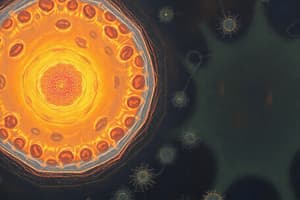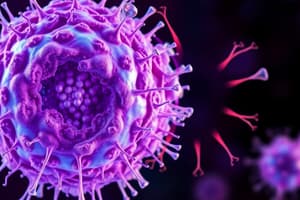Podcast
Questions and Answers
What role do cholesterol molecules play in the cell membrane?
What role do cholesterol molecules play in the cell membrane?
- They stabilize the cell membrane and modulate fluidity. (correct)
- They act as receptors for cell adhesion.
- They form the hydrophilic heads of the lipid bilayer.
- They facilitate the transport of polar molecules.
Which type of protein component is embedded in the lipid bilayer and extends across the membrane?
Which type of protein component is embedded in the lipid bilayer and extends across the membrane?
- Glycoproteins
- Carrier proteins
- Trans-membrane proteins (correct)
- Extrinsic proteins
What is the main function of the carbohydrate component on the external surface of the cell membrane?
What is the main function of the carbohydrate component on the external surface of the cell membrane?
- To provide selective permeability.
- To form a barrier against aqueous solutions.
- To serve as pathways for ions and water.
- To participate in cell adhesion and interactions. (correct)
How are the heads and tails of lipid molecules oriented in the cell membrane?
How are the heads and tails of lipid molecules oriented in the cell membrane?
Which of the following best describes intrinsic proteins in the cell membrane?
Which of the following best describes intrinsic proteins in the cell membrane?
What is the primary function of the Golgi apparatus?
What is the primary function of the Golgi apparatus?
Which type of lysosome is formed from the fusion of a primary lysosome and a phagocytic vesicle?
Which type of lysosome is formed from the fusion of a primary lysosome and a phagocytic vesicle?
What distinguishes the two faces of the Golgi apparatus?
What distinguishes the two faces of the Golgi apparatus?
Which organelle is primarily responsible for recycling cellular debris?
Which organelle is primarily responsible for recycling cellular debris?
What is the composition of a secondary lysosome in terms of its origin?
What is the composition of a secondary lysosome in terms of its origin?
Which of these components are found only in eukaryotic cells?
Which of these components are found only in eukaryotic cells?
Which feature is characteristic of prokaryotic cells?
Which feature is characteristic of prokaryotic cells?
What distinguishes plant cells from animal cells?
What distinguishes plant cells from animal cells?
Which cellular structure is responsible for protein synthesis in both prokaryotic and eukaryotic cells?
Which cellular structure is responsible for protein synthesis in both prokaryotic and eukaryotic cells?
Which of the following organelles is found in eukaryotic cells but not in prokaryotic cells?
Which of the following organelles is found in eukaryotic cells but not in prokaryotic cells?
What role does the cytosol play in the cell?
What role does the cytosol play in the cell?
Which structure is specifically found in the plant cells but not in animal cells?
Which structure is specifically found in the plant cells but not in animal cells?
Which organelle is involved in packaging and modifying proteins for export?
Which organelle is involved in packaging and modifying proteins for export?
What is the characteristic of the tunica intima in blood vessels?
What is the characteristic of the tunica intima in blood vessels?
Which type of capillary is characterized by having pores covered by a diaphragm?
Which type of capillary is characterized by having pores covered by a diaphragm?
What is a distinguishing feature of sinusoidal capillaries?
What is a distinguishing feature of sinusoidal capillaries?
What function does the tunica media serve in blood vessels?
What function does the tunica media serve in blood vessels?
Which layer of blood vessels contains loose connective tissue along with collagen and elastic fibers?
Which layer of blood vessels contains loose connective tissue along with collagen and elastic fibers?
What is the primary site of continuous capillaries?
What is the primary site of continuous capillaries?
What feature is typically absent in sinusoidal capillaries compared to other types?
What feature is typically absent in sinusoidal capillaries compared to other types?
What distinguishes the tunica adventitia from the tunica intima?
What distinguishes the tunica adventitia from the tunica intima?
What is the primary component of the cytoplasm?
What is the primary component of the cytoplasm?
Which of the following is a characteristic of the cell membrane?
Which of the following is a characteristic of the cell membrane?
Which component of the cell membrane is responsible for its fluidity?
Which component of the cell membrane is responsible for its fluidity?
What type of organelles are mitochondria classified as?
What type of organelles are mitochondria classified as?
Which of the following is NOT a non-membranous organelle?
Which of the following is NOT a non-membranous organelle?
What are inclusions in the context of cytoplasm?
What are inclusions in the context of cytoplasm?
What are the two main categories of organelles found in the cytoplasm?
What are the two main categories of organelles found in the cytoplasm?
What type of proteins are located on the outer surface of the cell membrane?
What type of proteins are located on the outer surface of the cell membrane?
Flashcards are hidden until you start studying
Study Notes
Prokaryotes vs. Eukaryotes
- Prokaryotes are simple cells that lack a nucleus and other membrane-bound organelles.
- Eukaryotes are complex cells containing a nucleus and other membrane-bound organelles.
- Both contain DNA and ribosomes.
- Eukaryotes contain an endoplasmic reticulum, Golgi apparatus, lysosomes, vacuoles, mitochondria, and a cytoskeleton.
Prokaryotic Examples
- Bacteria are the only prokaryotic organisms.
Eukaryotic Examples
- Two types of eukaryotic cells: plant and animal.
Animal Cells
- Contain all the typical eukaryotic organelles.
Plant Cells
- Share many organelles with animal cells, but also contain a cell wall, chloroplasts, and a large central vacuole.
Cytoplasm
- The cytoplasm comprises the cytosol and the organelles suspended within it.
- The cytosol is a viscous colloidal solution containing proteins, carbohydrates, lipids, enzymes, minerals, ions, and salts.
- Organelles are permanent living structures essential for vital processes.
- Inclusions are temporary structures, not essential for the vitality of cells.
Organelles
-
Membranous Organelles:
- Plasma membrane: The boundary of the cell, composed of a phospholipid bilayer with embedded proteins.
- Mitochondria: The "powerhouses" of the cell, responsible for ATP (energy) production.
- Endoplasmic Reticulum (ER): A network of membranes involved in protein synthesis (rough ER) and lipid synthesis (smooth ER).
- Golgi Apparatus: Modifies, sorts, and packages proteins and lipids synthesized in the ER.
- Lysosomes: Membrane-bound organelles containing hydrolytic enzymes for breaking down cellular debris and foreign materials.
-
Non-membranous Organelles:
- Ribosomes: Sites of protein synthesis.
- Cytoskeleton: A network of protein fibers that provides structural support and aids in cell movement.
Molecular Structure of the Cell Membrane
-
Lipid Component:
- Phospholipid molecules: Form the lipid bilayer, with hydrophilic heads facing the exterior and hydrophobic tails facing the interior.
- Cholesterol molecules: Stabilize the membrane and modulate its fluidity.
-
Protein Component:
- Extrinsic (peripheral) proteins: Loosely attached to the surface of the membrane.
- Intrinsic (integral) proteins: Embedded within the membrane, including transmembrane proteins that act as pathways for transporting ions and molecules.
-
Carbohydrate Component:
- Glycoproteins and glycolipids form the cell coat (glycocalyx) on the external surface.
- It contains receptors involved in cell adhesion and other interactions.
Golgi Apparatus
- Consists of flattened saccules arranged in stacks.
- The entry face (cis face) receives transfer vesicles from the rough ER.
- The exit face (trans face) releases secretory vesicles.
Lysosomes
- Membrane-bound organelles containing hydrolytic enzymes.
- Involved in digesting food particles, nutrients, foreign materials, and dead cells.
- Origin: Originate from the Golgi apparatus.
- Types: Primary lysosomes (homogenous), secondary lysosomes (heterogeneous, including phagolysosomes, multivesicular bodies, and autolysosomes).
The Cell
- Contains a cytoplasm, a fluid-filled space within the cell membrane, and a nucleus, which contains the cell's genetic material.
Blood Capillaries
- Small, thin-walled vessels that connect arterioles to venules.
- Formed by a single layer of simple squamous epithelium resting on a basal lamina.
- Types: Continuous capillaries (most common), fenestrated capillaries (with pores), and sinusoidal capillaries (large and irregular).
General Structure of Blood Vessels
- Three layers:
- Tunica Intima: Innermost layer, in contact with the bloodstream.
- Tunica Media: Middle layer, composed of smooth muscle and elastic fibers.
- Tunica Adventitia: Outermost layer, connects the vessel to surrounding tissues.
Studying That Suits You
Use AI to generate personalized quizzes and flashcards to suit your learning preferences.




